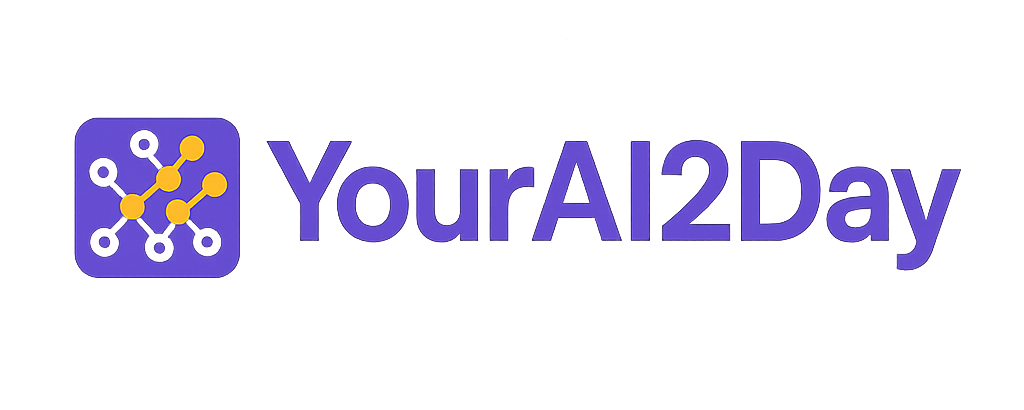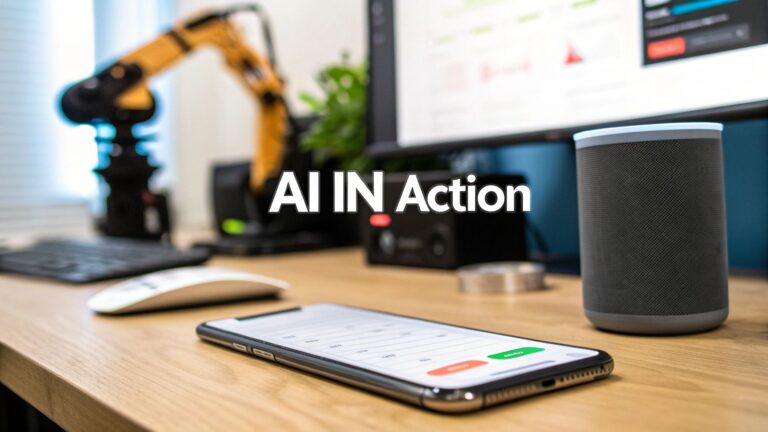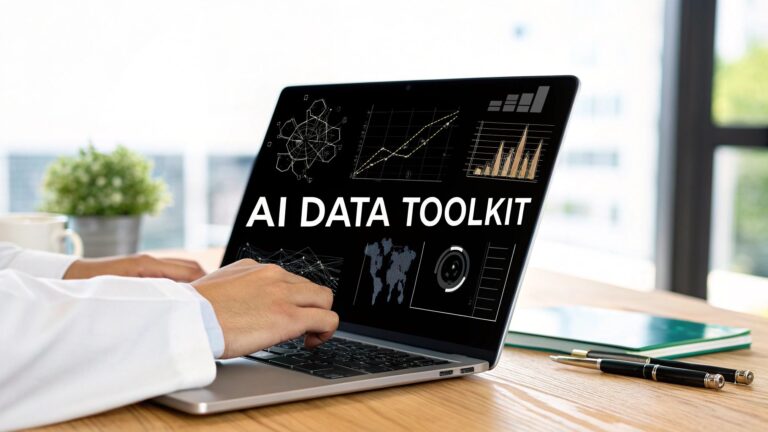AI Solutions for Business: Your Friendly Guide to Growth and Efficiency
Ever feel like your competitors have some secret weapon you don't? Chances are, that secret is AI solutions for business. We're not talking about sci-fi robots or futuristic tech for massive corporations anymore. AI has become a practical, everyday tool that can give any business, including yours, a serious leg up.
Think of AI less like a complicated piece of software and more like a new strategic partner. It’s a teammate dedicated to helping you work smarter, not harder, and unlock new avenues for growth.
Why Your Business Is Ready for AI Right Now
If you've been on the fence about artificial intelligence, consider this your friendly nudge to jump in. The big question for businesses isn't if they should adopt AI anymore, but how fast they can get it working for them. Don't let the technical jargon scare you off—today’s AI tools are designed for people like you: business owners, managers, and marketers, not just data scientists.
Imagine bringing on a team of tireless assistants who love doing the tedious work that bogs down your team. They can analyze sales data to find surprising trends, give your customers instant support day or night, and handle repetitive tasks with perfect accuracy. This isn't about replacing your talented people; it's about freeing them up to focus on what humans do best—big-picture strategy, creative problem-solving, and building real relationships with your customers.
The Shift from Niche Tech to Mainstream Tool
Not long ago, launching an AI project required a huge budget and a team of specialists. That's all changed. Today, a wave of user-friendly platforms and affordable subscription plans has put incredibly powerful AI within reach for businesses of every size, from a solo entrepreneur to a mid-sized company.
The numbers tell a clear story. AI adoption statistics show that AI in business is skyrocketing. It’s no longer a "nice-to-have" novelty; it's becoming a core part of a modern business strategy.
As Christina Inge, a Marketing Analytics expert, puts it: "Your job will not be taken by AI. It will be taken by a person who knows how to use AI."
This quote perfectly captures the current reality. The risk isn't the technology itself; it's falling behind competitors who are already using AI to move faster and make smarter decisions. And believe it or not, getting started is much easier than you probably think.
Understanding the Different Types of AI Tools
Getting your head around AI can feel a bit overwhelming, but let's break it down. The key is to stop thinking of "AI" as one giant, mysterious thing. Instead, think of it as a team of specialists you can hire, each with a specific skill set for different business challenges.
Your first and most important job is figuring out which specialist you need. Match the right type of AI to your specific business goal, and you'll see amazing results. Pick the wrong one, and you’ll just be spinning your wheels.
Let’s meet the main players on your new AI team.
Generative AI: The Creative Powerhouse
This is the type of AI that’s been all over the news, and for good reason. Generative AI is your creative engine. Think of it as an endlessly imaginative brainstorming partner who can produce brand-new content in seconds. We’re talking blog posts, ad copy, unique images, social media updates, and even snippets of code. For any business, this is a massive boost for marketing and content creation.
For example, what if you could draft five different versions of a promotional email in the time it takes to make a cup of coffee? Or create a custom image for your latest blog post without hiring a graphic designer? That’s the magic of generative AI.
- Practical Example: A small e-commerce shop uses a tool like Jasper or ChatGPT to write engaging product descriptions for its entire 500-item catalog. A task that would have taken a human writer weeks is now done in a couple of days.
- Another Example: A marketing department uses an AI image generator like Midjourney to create a dozen visual concepts for a new campaign. This lets them test what resonates with their audience before spending a dime on a professional photoshoot.
The growth in this area is staggering. The global Generative AI market is expected to see explosive growth, showing just how much value businesses are starting to unlock. You can get more insights on AI's economic impact from Mission Cloud.
Predictive AI: The Data Analyst
If generative AI is the creative artist, then Predictive AI is your sharp, numbers-focused analyst. This type of AI loves digging into your past and present data to forecast what's likely to happen next. It’s all about helping you make smarter, more confident decisions backed by real evidence, not just gut feelings.
This is the tool that helps you answer mission-critical questions like, "Which of my customers are at risk of leaving?" or "What are our sales likely to be next quarter?" It finds the hidden patterns in your data and turns them into a practical roadmap. Our guide on AI data analysis tools dives much deeper into how this works.
Automation AI: The Efficient Administrator
Last but not least, we have Automation AI—the tireless workhorse of your team. This AI is designed to take over all those repetitive, rule-based tasks that eat up so much time. Think data entry, scheduling, or sorting emails. It handles the grunt work with perfect accuracy, freeing up your people for more valuable, creative projects.
An expert in business process improvement might say, "The goal of AI-powered automation isn't to replace people, but to augment their abilities. It handles the mundane so your team can focus on the meaningful."
This infographic does a great job of showing how these different AI benefits—automation, deep insights, and better customer experiences—all fit together to create a more powerful business.
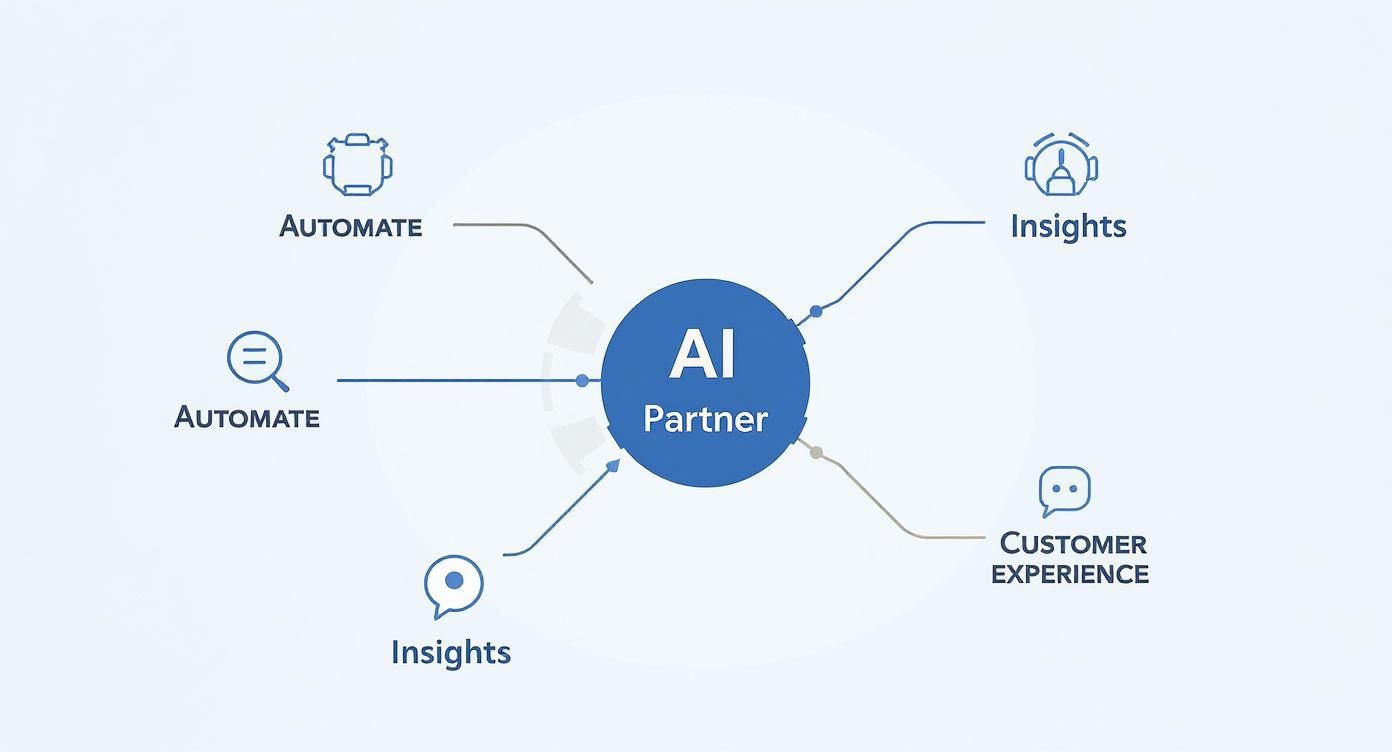
As you can see, the real magic happens when you combine these different types of AI. Together, they create a well-rounded strategy that makes your entire operation smarter and more efficient.
Real-World Examples of AI Transforming Industries
Theory is great, but seeing how AI solutions for business actually work in the wild is what makes it all click. These aren't just abstract ideas for giant corporations; companies of all sizes are already using AI to solve real, everyday problems and get an edge. It’s happening right now, in industries you see every day.
For instance, think about a local retail shop that's always guessing how much stock to order, ending up with too much of one thing and not enough of another. With a simple predictive AI tool, they can analyze past sales, local events, and even weather patterns to forecast demand with surprising accuracy. That means fewer items on the clearance rack and more happy customers who find what they came for.
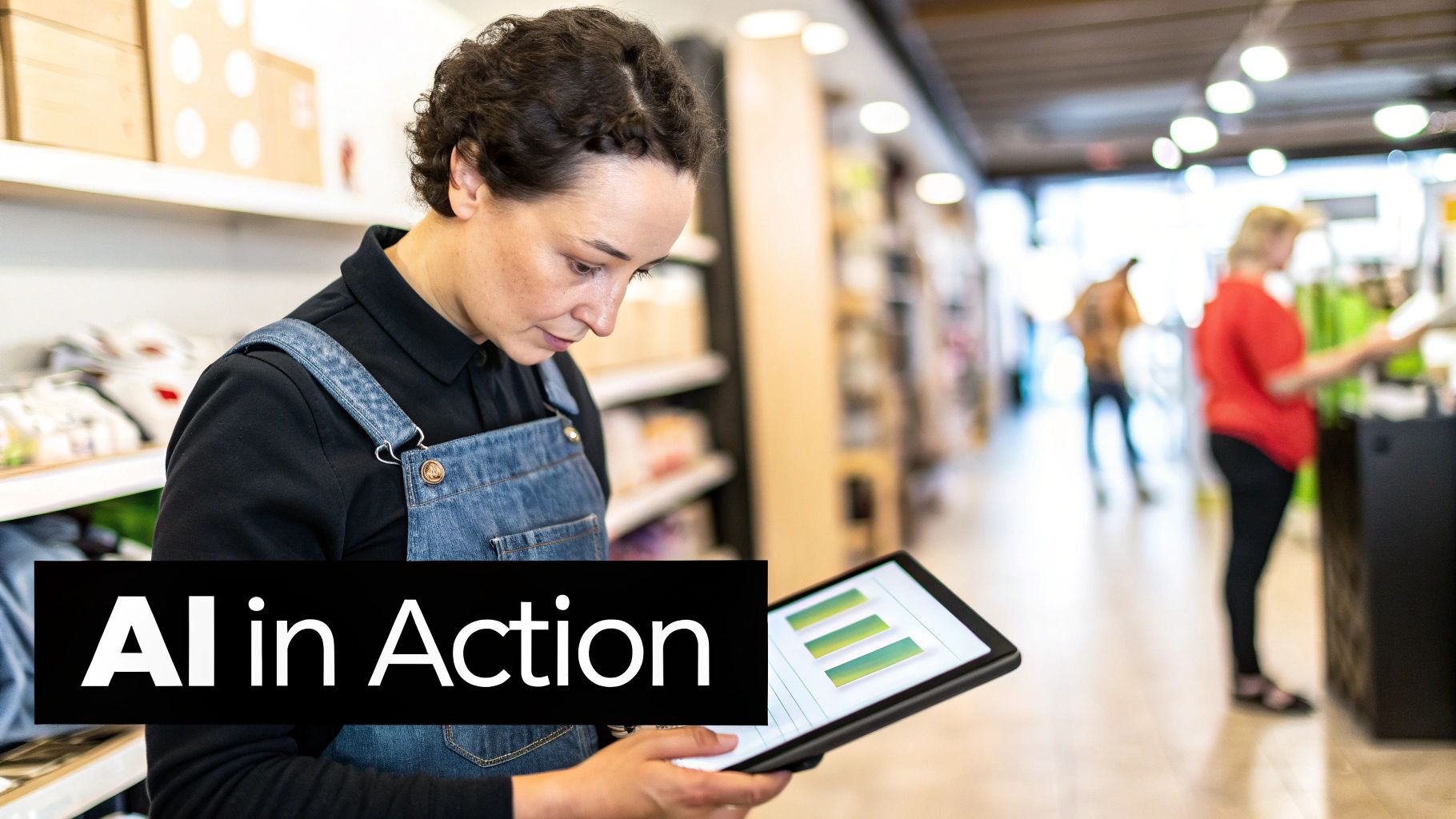
This is where AI truly shines—by taking raw data and turning it into a real-world business advantage.
AI in Marketing and Customer Service
Marketing and customer service were some of the first areas to get a major boost from AI. Small agencies and in-house teams now use generative AI to create personalized email campaigns at a scale that was once impossible. Instead of blasting one generic message, they can create hundreds of slightly different versions for specific customer groups, which naturally leads to better open rates and more sales.
AI-powered chatbots have also become a friendly face for customer support. They offer instant help 24/7, answering common questions like "Where is my order?" and letting human agents focus on the trickier problems that require a personal touch.
Here’s where you’ll see it most often:
- Hyper-Personalization: AI algorithms analyze a customer's browsing habits to suggest products they'll actually love, just like Amazon’s famous recommendation engine.
- Content Creation: Tools like Jasper or Microsoft Copilot can help you draft blog posts, social media captions, and ad copy in minutes, freeing up your team to focus on overall strategy.
- Customer Support: A well-trained AI chatbot can handle up to 80% of routine customer questions, slashing wait times and making your support team's life easier.
"AI is a tool, not a replacement. The real advantage comes from knowing how to use it well to better serve your customers and empower your team." – Business Technology Consultant
To get a broader view, it's worth exploring the many practical applications of artificial intelligence across different fields.
Boosting Operational Efficiency
Beyond the customer-facing side, AI is a champion at making your internal operations run smoother. Imagine a finance team drowning in paperwork during month-end close. An automation tool can scan, pull data from, and categorize thousands of invoices with near-perfect accuracy. A task that once took a full week can now be done in just a few hours.
In logistics, companies use AI to map out the most efficient delivery routes on the fly. The system considers live traffic, weather, and delivery windows to find the fastest path, saving a ton on fuel and time. These aren't futuristic dreams; they are practical applications happening today.
The Real-World Gains of Bringing AI into Your Business
So, what's the actual payoff when you invest in AI? It’s not about chasing the latest tech trend. It's about seeing real, measurable improvements in how your business runs every day. The advantages really boil down to three game-changing pillars: making your team more productive, helping you make smarter decisions, and creating customer experiences people love.
Think of AI as a force multiplier for your staff. It takes on the repetitive, time-sucking tasks, freeing up your team to focus on the strategic work that actually grows the company. It’s like clearing all the administrative clutter off their plates so they can finally concentrate on the big picture.
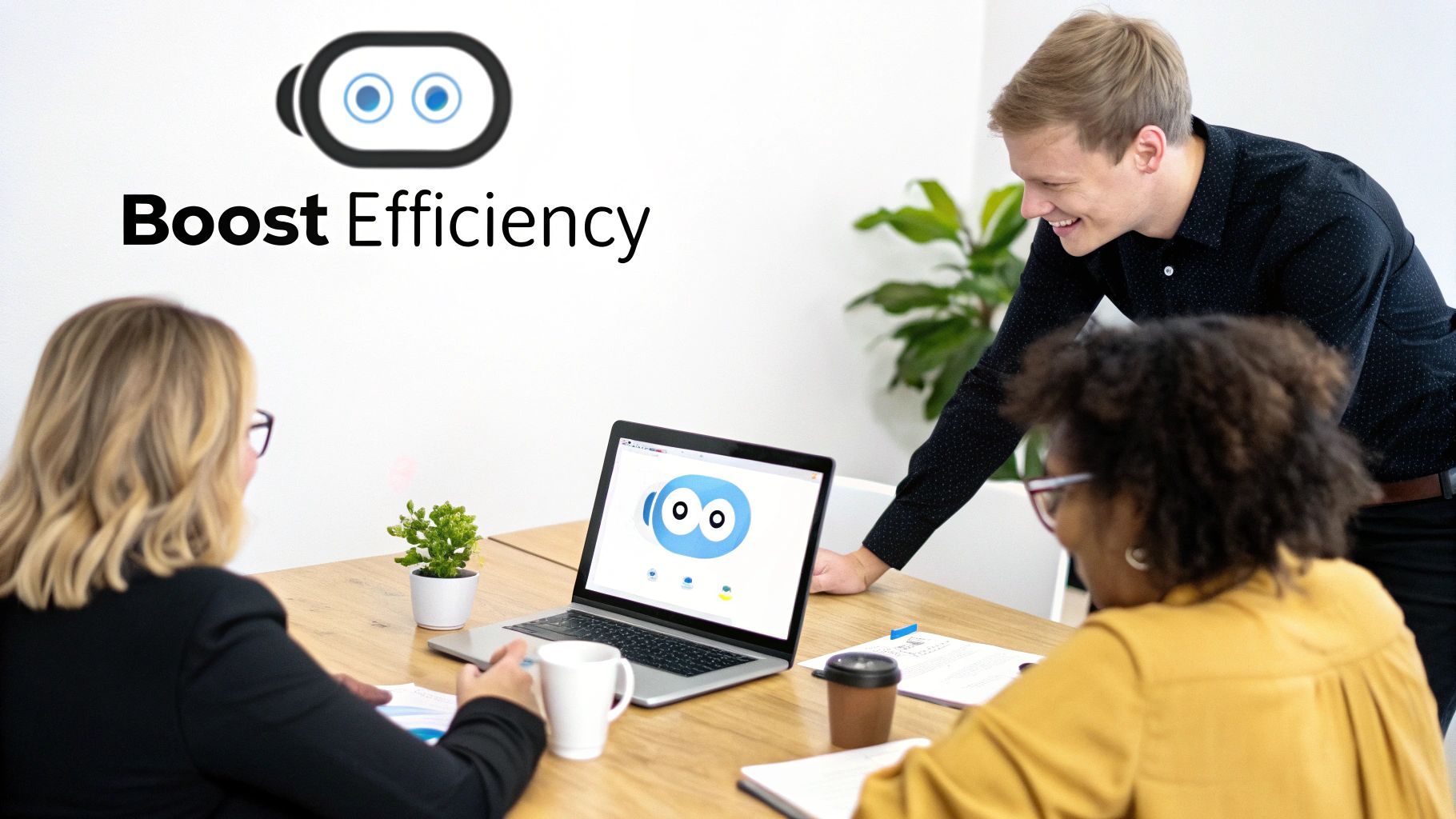
This shift from manual grunt work to automated efficiency isn't just a time-saver; it directly impacts your bottom line. It's about giving your team back their most valuable resource: time.
Gaining True Clarity with Data-Driven Insights
In business, a good guess is never as powerful as knowing. AI is fantastic at sifting through massive amounts of data to find subtle patterns and trends that are simply invisible to the human eye. This is how you shift from relying on gut feelings to building strategies based on hard evidence.
Instead of just reacting to what the market does, predictive AI lets you get ahead of the curve. It can help you forecast sales, spot which customers might be thinking of leaving, and uncover new opportunities for growth. It’s less like a crystal ball and more like a powerful magnifying glass for your own business data, helping you make confident, profitable decisions.
A seasoned business analyst might tell you, "The goal of AI isn't to replace human intuition, but to supercharge it with data. It gives you the evidence you need to back up your best ideas."
Creating a Standout Customer Experience
Finally, let’s talk about your customers. AI is a total game-changer for building loyalty and satisfaction. Today's buyers expect fast, personalized service, and AI is the key to delivering that. Tools like 24/7 chatbots and smart personalization engines work around the clock to create a smooth, tailored journey for every single person.
For instance, an e-commerce site can use AI to serve up product recommendations so spot-on it feels like a personal shopper is on the other side of the screen. That kind of bespoke attention is what builds true loyalty and turns casual buyers into raving fans.
How AI Transforms Business Departments
You can see these benefits ripple across nearly every part of an organization. Here’s a quick look at how different departments put AI to work for tangible results.
| Department | AI Application Example | Primary Benefit |
|---|---|---|
| Marketing | Using generative AI to create personalized ad copy for different audience segments. | Enhanced Customer Engagement |
| Sales | Implementing a predictive lead scoring system to prioritize the most promising prospects. | Increased Conversion Rates |
| Operations | Automating inventory management with AI-powered demand forecasting. | Reduced Costs and Waste |
| HR | Using an AI tool to screen resumes for specific skills and qualifications. | Faster, More Efficient Hiring |
From finding the right people to keeping your customers happy, AI provides the tools to work smarter, not just harder, in every corner of your business.
How to Choose the Right AI Solution for Your Company
With so many AI solutions out there, picking the right one can feel like finding a needle in a haystack. But here's a secret: you don't need to be a tech genius to make a great choice. The key is to ignore the hype and focus on what your business actually needs.
The most common mistake businesses make is getting dazzled by a cool new tool without a clear problem for it to solve. Before you even start browsing, ask yourself one simple question: What's our biggest headache right now? Is your team buried in manual data entry? Are your marketing campaigns missing the mark? Are you losing sales because follow-up is too slow?
Zeroing in on that specific challenge becomes your North Star. It instantly cuts through the noise and shrinks your list of potential tools from thousands down to a manageable few.
Start with Your Problem, Not the Tech
Think of it this way: you wouldn't hire a new employee just because they have an impressive resume. You'd hire them to fill a specific role. Treat AI the same way. Find a tool that solves a clear business problem you're facing today.
Once you’ve identified the problem, do a quick reality check on what you have to work with.
- Look at Your Data: AI needs data to learn. Is your data clean and organized? A sales forecasting tool, for instance, won't be much help without a solid history of sales figures.
- Check Your Team's Skills: Is the tool simple enough for your current team to use, or will it require hiring a specialist? Always lean toward solutions with friendly interfaces that don't require a computer science degree to operate.
Vet Your Potential AI Partners
Choosing an AI solution is more than a software purchase; it's a partnership. You need to know who you’re getting into business with. A fantastic tool with zero support can quickly become an expensive headache.
As Christina Inge says, "Your job will not be taken by AI. It will be taken by a person who knows how to use AI." This is especially true when choosing a tool—you need a partner who helps your team learn how to use it effectively.
Here’s a simple checklist of questions to ask any potential AI vendor:
- How, exactly, does your tool solve my specific problem? Make them connect their features directly to your pain point. Don't accept vague answers.
- What does training and setup look like? Get a clear timeline and understand what resources they'll provide to get your team up and running.
- Will this solution grow with us? The tool that fits today should be able to scale up as your business expands.
- What's your customer support like? When—not if—you hit a snag, you need to know you can get a real, knowledgeable human to help you out, fast.
Finally, resist the urge to go for a massive, company-wide rollout right away. The smartest way to get started is to launch a small pilot project. Pick one department or a single workflow and test the AI in a controlled setting. This "crawl, walk, run" approach lets you see the real-world impact and learn valuable lessons before making a bigger commitment. It’s your safest bet for a successful start with AI.
Your First Steps in AI Implementation
Ready to take the first step? Awesome. This isn't about becoming a tech expert overnight. It's a simple, practical roadmap to get your first AI project off the ground without overwhelming your team.
We’re going to focus as much on the people as we do on the technology. Think of it as a “crawl, walk, run” approach—you’ll learn and adapt as you go.
Your first step is to get your team excited, not scared. Show them what's in it for them. Explain how AI can act like a helpful assistant, taking over the boring parts of their jobs so they can focus on more interesting work. It helps to use simple analogies. You might compare your first AI project to putting training wheels on a bike—it’s a safe way to learn before you start riding solo.
Build Support and Define Goals
Getting your key players involved from day one is crucial. A great way to start is with a brief demo using sample data to show them what the tool can do. When people see the potential, they get on board.
Next, you need to set clear and measurable goals. Vague objectives like "improve efficiency" won't cut it. Be specific. A good goal might be "reduce the time it takes to generate weekly sales reports by 50%" or "cut customer response times for common questions by 75%."
And don't forget the data! Start with a clean, well-organized batch of data. This helps your AI model deliver reliable results from the get-go.
Steps to Prepare Your Team
- Communicate The Vision: Draft a simple, one-page summary of what you hope to achieve and share it with everyone involved. Keep it jargon-free!
- Create Small Wins: Find a quick, easy task for AI to automate first, like sorting incoming emails or categorizing support tickets. Early wins build momentum.
- Train and Upskill: Host a casual 30-minute workshop to walk everyone through the new tool. Make it interactive and fun.
As one AI adoption expert often says, "Successful AI integration is 20% technology and 80% people and process."
Remember to create a feedback loop. Set up weekly check-ins to talk about what's working, what's frustrating, and how you can improve the process.
Crawl, Walk, Run Approach
Start with a small, focused pilot project in a single department. This trial is your set of training wheels. It gives you a safe space to experiment and learn before you roll it out more widely.
Here’s a simple way to structure your first project:
- Pick just one process you want to improve.
- Measure how it performs right now, before AI.
- Introduce the tool, make adjustments in weekly sprints, and keep a close eye on your progress.
Check out our guide on implementing AI in business for a much deeper look into each phase and how to sidestep common pitfalls.
Once you have a few wins under your belt, you can start expanding the pilot to other teams. This keeps the energy high and the lessons you've learned fresh. Before long, you'll see your teams shifting their focus from repetitive grunt work to the kind of strategic projects that truly move the needle. Celebrate every milestone—it's a great way to reinforce this new, smarter way of working.
Ready for more AI insights? Discover how YourAI2Day can help you stay ahead in AI solutions for business. https://www.yourai2day.com
